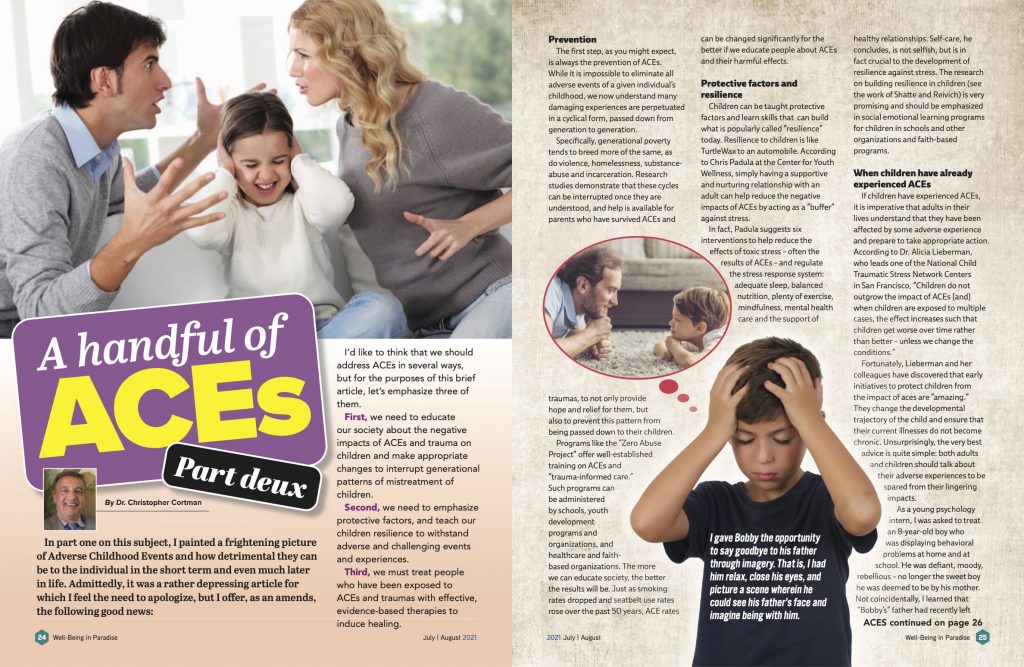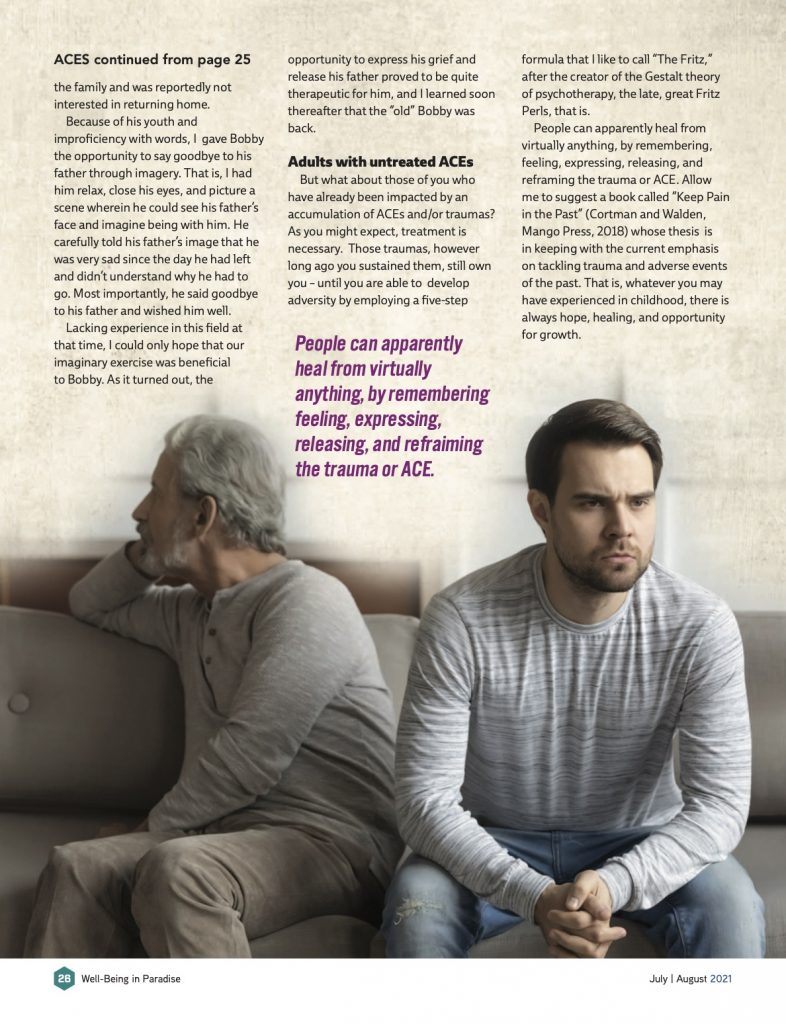Article written for the Venice Gondolier’s Well Being in Paradise Magazine | July/August 2021
In part one of this article, I painted a frightening picture of Adverse Childhood Events (ACEs) and how detrimental they can be to the individual in the short term and even much later in life. Admittedly, it was a rather depressing article for which I feel the need to apologize, but I offer, as an amends, the following good news:
I’d like to think that we should address ACEs in several ways, but for the purposes of this brief article, let’s emphasize three of them. First, we need to educate our society about the negative impacts of ACEs and trauma on children and make appropriate changes to interrupt generational patterns of mistreatment of children. Second, we need to emphasize protective factors, and teach our children resilience to withstand adverse and challenging events and experiences. Third, we must treat people who have been exposed to ACEs and traumas with effective, evidence-based therapies to induce healing.
Prevention
The first step, as you might expect, is always the prevention of ACEs. While it is impossible to eliminate all adverse events of a given individual’s childhood, we now understand many damaging experiences are perpetuated in a cyclical form, passed down from generation to generation. Specifically, generational poverty tends to breed more of the same, as do violence, homelessness, substance-abuse and incarceration. Research studies demonstrate that these cycles can be interrupted once they are understood, and help is available for parents who have survived ACEs and traumas, to not only provide hope and relief for them, but also to prevent this pattern from being passed down to their children. Programs like the “Zero Abuse Project “, offer well-established training on ACEs and “trauma-informed care.” Such programs can be administered by schools, youth development programs and organizations, and healthcare and faith-based organizations. The more we can educate society, the better the results will be. Just as smoking rates dropped and seatbelt use rates rose over the past fifty years, ACE rates can be changed significantly for the better if we educate people about ACEs and their harmful effects.
Protective Factors and Resilience
Children can be taught protective factors and learn skills that can build what is popularly called “resilience” today. Resilience to children is like turtle wax to an automobile. According to Chris Padula at the Center for Youth Wellness, simply having a supportive and nurturing relationship with an adult can help reduce the negative impacts of ACEs by acting as a “buffer“ against stress. In fact, Padula suggests six interventions to help reduce the effects of toxic stress–often the results of ACEs–and regulate the stress response system: adequate sleep, balanced nutrition, plenty of exercise, mindfulness, mental health care and the support of healthy relationships. Self-care, he concludes, is not selfish, but is in fact crucial to the development of resilience against stress. The research on building resilience in children (see the work of Shatte and Reivich) is very promising and should be emphasized in social emotional learning (SEL) programs for children in schools and other organizations and faith-based programs.
When Children Have Already Experienced ACEs
If children have experienced ACEs, it is imperative that adults in their lives understand that they have been affected by some adverse experience and prepare to take appropriate action. According to Dr. Alicia Lieberman, who leads one of the National Child Traumatic Stress Network Centers in San Francisco, “Children do not outgrow the impact of ACEs, and when children are exposed to multiple cases the effect increases such that children get worse over time rather than better – unless we change the conditions. ”Fortunately, Lieberman and her colleagues have discovered that early initiatives to protect children from the impact of aces are “amazing.” They change the developmental trajectory of the child and ensure that their current illnesses do not become chronic. Unsurprisingly, the very best advice is quite simple: both adults and children should talk about their adverse experiences to be spared from their lingering impacts.
As a young psychological intern, I was asked to treat an eight-year-old boy who was displaying behavioral problems at home and at school. He was defiant, moody, rebellious–no longer the sweet boy he was deemed to be by his mother. Not coincidentally, I learned that “Bobby’s“ father had recently left the family and was reportedly not interested in returning home.
Because of his youth and improficiency with words, I gave Bobby the opportunity to say goodbye to his father through imagery. That is, I had him relax, close his eyes, and picture a scene wherein he could see his father’s face and imagine being with him. He carefully told his father‘s image that he was very sad since the day he had left and didn’t understand why he had to go. Most importantly, he said goodbye to his father and wished him well. Lacking experience in this field at that time, I could only hope that our imaginary exercise was beneficial to Bobby. As it turned out, the opportunity to express his grief and release his father proved to be quite therapeutic for him, and I learned soon thereafter that the “old“ Bobby was back.
Adults with Untreated ACEs
But what about those of you who have already been impacted by an accumulation of ACEs and/or traumas? As you might expect, treatment is necessary. Those traumas, however long ago you sustained them, still own you–until you are able to develop adversity by employing a five-step formula that I like to call “The Fritz,” after the creator of the Gestalt theory of psychotherapy, the late, great Fritz Perls, that is.People can apparently heal from virtually anything, by remembering, feeling, expressing, releasing, and reframing the trauma or ACE. Allow me to suggest a book called “Keep Pain in the Past” (Cortman and Walden, Mango Press, 2018) whose thesis is in keeping with the current emphasis on tackling trauma and adverse events of the past. That is, whatever you may have experienced in childhood, there is always hope, healing, and opportunity for growth.



I need to to thank you for this wonderful read!!
I absolutely loved every little bit of it. I have got
you book-marked to look at new stuff you post…
I want to to thank you for this great read!! I definitely loved every bit of it.
I’ve got you book marked to look at new stuff you post…